Report
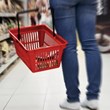
Executive summary
In this report, we continue our coverage of the two-speed growth trend that has characterized China’s fast-moving consumer goods (FMCG) sector for the past two years. We also share our analysis of how, after four years of rapid growth, digital sales are changing—and not changing—shopper behavior in China.
It’s still a slow road to growth for China’s FMCG market. The sluggishness that began in 2011 continued through the first half of 2017, forcing brands to innovate new ways to spur household penetration and gain market share. Although the second quarter of 2017 showed a slight uptick in sales, overall value growth for the first half was a mere 2.0% over the same period in 2016, largely due to a volume decline of 0.3% and unimpressive average selling price (ASP) growth of 2.3%. Viewed separately, offline sales did even worse, gaining only 0.4% in value due to a 1.1% drop in volume and ASP growth of only 1.4%.
However, these numbers mask some important nuances. While many categories are losing steam, some are charging ahead, reflecting a continuation of the two-speed growth environment that we first wrote about in our 2016 China Shopper reports. It is a new reality that now guides many brands as they develop strategies for growing in China.
Food and beverage categories continued their two-year trend of negative volume growth. But as the majority of those categories saw growth decline, a few of them—most notably yogurt and packaged water—did exceptionally well, evidence of Chinese consumers’ continuing passion for health and wellness and their rejection of products considered less healthy, such as chewing gum and confectionery. Indeed, adding healthy ingredients or emphasizing lifestyle improvement were the moves that helped some food and beverage brands outpace their categories. The introduction of such premium products elevated Nongfu in the ready-to-drink tea category and Uni-President in instant noodles.
In a trend that began in 2014, personal care and home care categories continued to diverge from food and beverage categories in their growth trajectories. Market value rose by 8.3% in the personal care sector, for example. But while that gain sounds healthy compared with other sectors’ performance, it represents the first slowdown for personal care in four years. There’s a solid reason for the stalling of this high-speed sector. South Korea’s decision in mid-2016 to deploy the Terminal High-Altitude Area Defense (Thaad) system to neutralize missile threats from North Korea created anti-South Korea sentiment in China, causing repercussions in the cosmetics aisle as Chinese consumers shunned popular South Korean imports. Sales of South Korean skin care and makeup products dropped 4.8% in the first half of 2017, and hot brands such as Innisfree experienced double-digit negative value growth on Tmall and Taobao in the months following the Thaad announcement. Because many of those imported brands sell at a premium, personal care ASP growth felt the effects, falling from 8.4% last year to 5.7% this year.
China’s shopper behavior is evolving as online commerce steadily gains acceptance. For example, our study found that, overall, shoppers are purchasing less frequently, a trend that has been building over the past several years along with the growth of e-commerce. When shoppers buy online, they tend to place bigger orders, forgoing trips to the hypermarket or supermarket. Also, we observed that the decline in purchase frequency is more pronounced in food and beverage categories. As we explained in China Shopper Report 2017, Vol. 1 (China’s Two-Speed Growth: In and Out of the Home), digital capabilities have given rise to a boom in food delivery services, rapidly changing meal habits for Chinese consumers. They’re cooking at home much less and purchasing more food and beverages than ever before in restaurants, for in-home delivery or for on-the-go consumption. As out-of-home meal spending rises, consumers buy less frequently from offline grocery channels for at-home consumption.
While e-commerce has brought about clear changes, rising digital activity doesn’t seem to be having a big effect on some other elements of shopper behavior. Consider brand loyalty. Since 2012 we have defined each of the FMCG categories we track as either “repertoire” or “loyalist.” In repertoire categories, the more frequently consumers shop, the more brands they try. In loyalist categories, shoppers buy the same brands regardless of increasing frequency. We found that the categories still break down along the same lines as they did when we first began researching brand loyalty. Now we’ve determined that a category’s online penetration doesn’t affect where it lands on the repertoire-loyalist continuum. Similarly, shoppers’ movements between offline and online channels don’t change loyalty patterns. In categories that exhibit the most loyalist activity, such as milk, diapers and infant formula, shoppers display the same behavior as they did in 2013, when online commerce was less prevalent. In fact, they may be staying loyal in part because the online channel makes it so convenient with services like one-click repurchasing and automatic replenishment. In repertoire categories such as skin care, shampoo and candy, consumers tend to buy even more brands than they did in 2013. That may be because of the proliferation of new brands, including digital insurgents, entering the market.
As we first detailed in 2013, shoppers tend to buy from different categories online than they do offline. However, as China’s consumers place more trust in online platforms’ product quality, payment security, logistics and delivery—and are presented with extended offerings from diverse suppliers—they are buying from more categories online. Also, online ASPs continue to be higher than offline ASPs, due to the abundance of premium products purchased online. Promotions are still popular online, particularly during big shopping festivals such as Alibaba’s 11/11 and JD’s 6/18, but promotion rates are stabilizing.
Another important finding from our survey: Similar to what we learned in 2013, market share continues to be up for grabs. Across the categories studied, 22% of the top 10 brands in 2013 had dropped from that list by 2016, on average. In some categories it’s particularly tough to maintain market leadership. In yogurt, for example, the leader position has rotated among Mengniu, Yili and Bright. In skin care, 8 of the top 10 brands in 2013 had changed their rank three years later.
What makes a leader? Penetration. As we explained in China Shopper Report 2014, Vol. 2 (Chinese Shoppers: Three Things Leading Consumer Products Companies Get Right), the way to grow market share is to boost penetration. Bain & Company and Kantar Worldpanel studies of Chinese shopper behavior validate that penetration is more important than other measurements like purchase frequency or repurchase rate.
Yet even in the age of online shopping, with its ease of repurchasing, the shopper base continues to be a leaky bucket. Most buyers of a brand will choose a different brand within two years, requiring consumer goods companies to continuously recruit and re-recruit shoppers; they can’t expect shoppers to buy more or make more frequent purchases. Meanwhile, brands need to obsess over another critical component of the shopper base: low-frequency shoppers. Those who purchase a brand one or two times a year account for the majority of the shopper base for most brands and contribute most of the revenue, according to our analysis.
For companies hoping to navigate the two-speed growth and shopper behavior that’s evolving along with e-commerce, the answer is to earn consideration and penetration by investing in three key assets: memory structures, the product portfolio and in-store execution. But now, they need to view those assets in a digital context. L’Oréal does this very well with many of its brands in China, as does the online nut purveyor Three Squirrels.
Bruno Lannes, a partner with Bain's Consumer Products practice, discusses three main trends in China's two-speed growth environment.
Full report
Keeping up at two speeds
The overall slowdown for fast-moving consumer goods (FMCG) in China that began in 2011 continued through the first half of 2017, with the growth trajectories for food and beverage categories and personal and home care categories diverging for the third straight year (see Figure 1). FMCG sales rose slightly in the second quarter of 2017, but it wasn’t enough to offset the ongoing sluggishness. Value growth for the first half was a mere 2.0% over the same period in 2016. That’s the lowest market growth since 2012, due in large part to a 0.3% volume decline and lackluster 2.3% average selling price (ASP) growth (see Figure 2). As more Chinese consumers turn to their mobile phones, tablets or laptops to buy, offline sales saw negative volume growth for the fourth consecutive year and increased by only 0.4% in value, with ASP growth of 1.4%, in the first half of 2017.
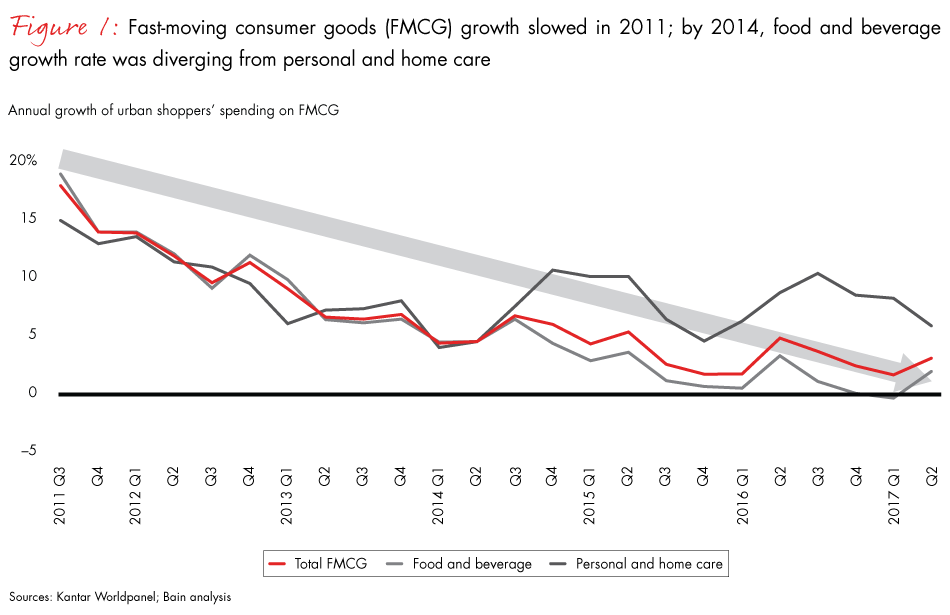
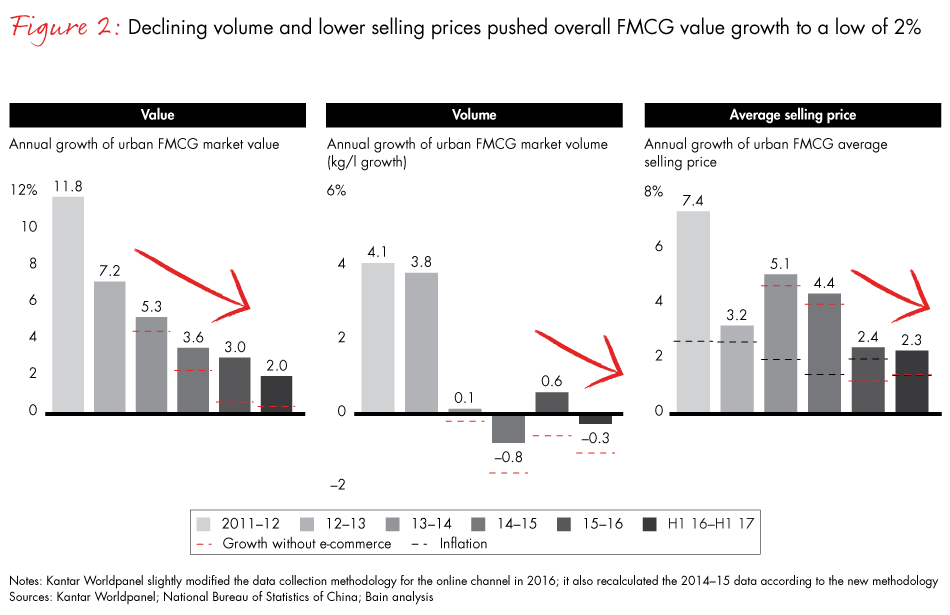
As in each of the past five years, we studied 106 FMCG categories purchased for home consumption in China, conducting a deep analysis of the key 26 categories that span the four largest consumer goods sectors: packaged food, beverages, personal care and home care.1 Combined, these sectors represent 80% of China’s FMCG purchases. This report, which updates the findings from China Shopper Report 2017, Vol. 1 (China’s Two-Speed Growth: In and Out of the Home), includes Kantar Worldpanel shopper behavior data for the first half of 2017. The new data provides insights into continuing trends that are critical for brands as they set a course for growth in the world’s largest FMCG market.
China has clearly established itself as a two-speed growth environment and not a single high-velocity market. We first discussed this key finding in our 2016 China Shopper reports, and many brands are using it as a guide for developing strategies. For example, food and beverages showed negative volume growth for the third straight year, and home care products also experienced a significant volume decline. By comparison, personal care showed impressive growth of 8.3% in the first half of 2017 (see Figure 3). Still, that represented the sector’s first drop in growth in four years. The slowdown can be traced to South Korea’s decision in mid-2016 to deploy the Terminal High-Altitude Area Defense (Thaad) system to neutralize missile threats from North Korea. In response, many Chinese shoppers boycotted South Korean brands. Sales of South Korean skin care and makeup products dropped 4.8% in the first half of 2017, with hot brands such as Innisfree suffering double-digit negative value growth on Tmall and Taobao in the months following the Thaad announcement. Because many of those imported brands sell at a premium, personal care ASP growth felt the effects, falling from 8.4% last year to 5.7% this year.
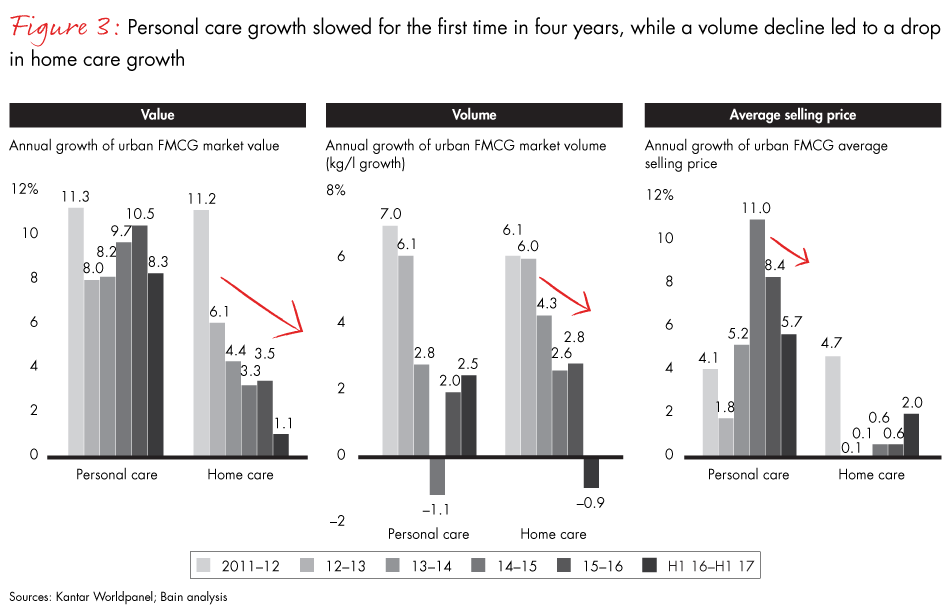
The two-speed growth pattern is evident among product categories. For example, while sales growth declined in most food and beverage categories, some saw robust growth. Yogurt and packaged water achieved particularly strong growth as Chinese consumers maintain their interest in food and beverages that they consider healthy. On the flip side, sales dropped in categories that consumers view as unhealthy. Chocolate, chewing gum and candy all registered double-digit negative volume growth in the first half of 2017. Across categories, one approach to jump-starting sales is to offer premium products that appeal to health or lifestyle improvement. In ready-to-drink (RTD) tea, Nongfu’s Tea Pi outpaced its category. The tea is fruit flavored, with packaging festooned with comic-style illustrations to entice young consumers. Nongfu increased its ASP in RTD tea by 9% from 2015 to 2016. Uni-President achieved similar success in instant noodles, increasing its ASP by 9% over the same period by launching such premium stock-keeping units (SKUs) as Soup Daren, which contains high-nutrition stock. The same emphasis on premiumization (selling products with price increases higher than the rate of inflation) helped personal care categories such as skin care and shampoo. Meanwhile, external factors played a role in the performance of some categories. For example, supply issues hurt the milk category as shipments from New Zealand and Europe declined in the first half of 2017.
How digital is changing Chinese shopper behavior
It’s no secret that e-commerce is winning the hearts of China’s shoppers. As we showed in China Shopper Report 2017, Vol. 1, online penetration is growing in every city tier and in every category. The steadily increasing acceptance of online shopping is changing some elements of buyer behavior in China. It is influencing purchase frequency, for example. When shoppers go online, they tend to place bigger orders, minimizing the need for more frequent purchases. Overall, purchase frequency has declined since 2013 (see Figure 4).
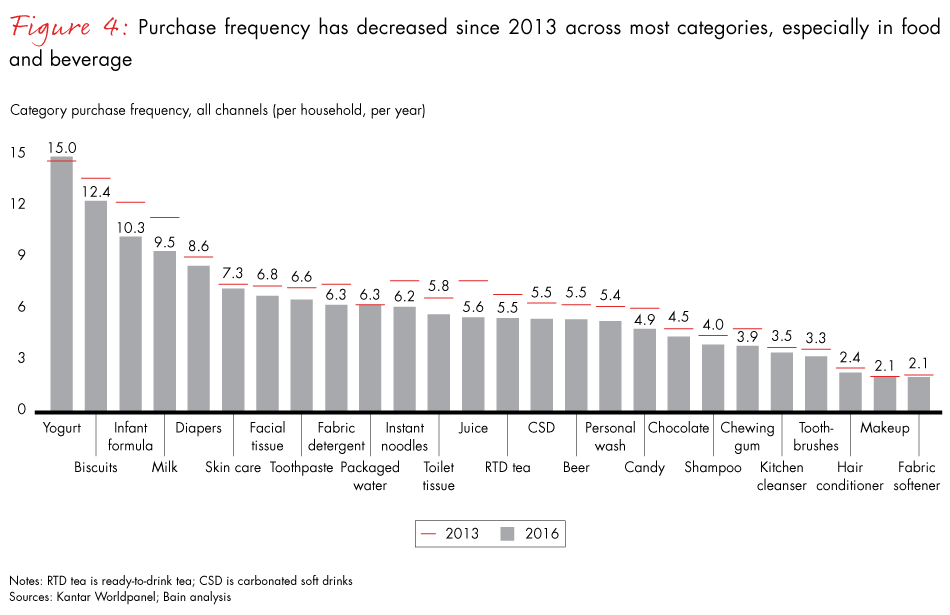
Other factors come into play, too. In the first volume of this year’s report, we chronicled the rapid rise in out-of-home food and beer consumption, fueled by the booming dine-out and food delivery markets. Meituan, China’s largest food delivery platform, has 300 million registered users and reports fulfilling more than 18 million orders a day. As more consumers rely on such services for their meals, there’s a corresponding drop in the frequency of food and beverage purchases for home consumption in offline grocery channels. While food and beverage categories saw the biggest drop in purchase frequency across channels, the trend is evident in categories as diverse as hair conditioner and fabric softener, which shoppers purchase only twice a year on average. In nearly all categories, order sizes are larger online than offline, which also partially explains the frequency decline. Overall, consumers purchase from few categories more than once a month, according to our analysis.
Also, as we first detailed in 2013, the categories that shoppers buy online tend to differ from those they purchase offline. That hasn’t changed, but the level of concentration represented by the top 10 categories online and offline is converging, as China’s consumers grow more comfortable with online platforms’ product quality, payment security and delivery (see Figure 5). That growing trust, combined with extended offerings from diverse suppliers, means that shoppers are buying from more categories online. In 2013, only 11% of households made online purchases in 6 or more of the 26 categories we track. By 2016, that group had more than doubled, to 24% of consumers. As shoppers buy more categories online, the lineup of categories from which they purchase starts to look more similar to the lineup of what they purchase offline.
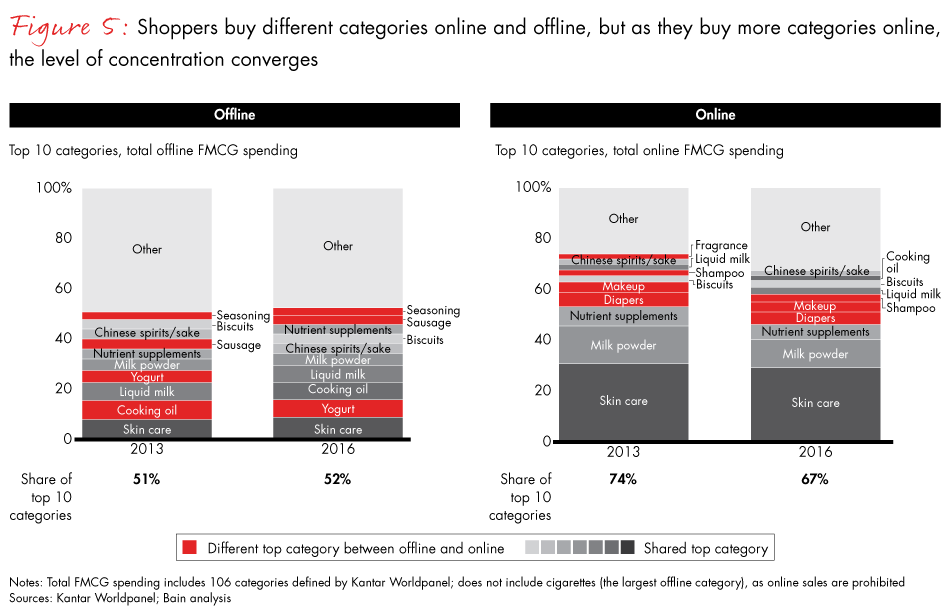
Many in the industry predicted that online would become a discount channel compared with offline. In fact, the reverse is true. Online ASPs continue to be higher than offline ASPs in many categories (see Figure 6). A big part of the reason: the abundance of premium products purchased online (see Figure 7). In toothbrushes, offline market leader Colgate sells for an average RMB 5. Online, electric toothbrushes make up almost all of the top two brands’ sales, contributing to much higher ASPs. The online leader, Oral-B, carries an average price of RMB 82, and the second-place brand, Philips, sells for an average price of RMB 191. On the other hand, the ASP for the same SKU is generally lower online (see Figure 8). For example, in our recent study, a 368-gram container of Danisa Butter Cookies cost an average RMB 32.7 in a physical store compared with RMB 32.1 online. We are, however, seeing more convergence in the online and offline brand mix and prices in categories such as biscuits and shampoo. In milk and other categories, prices for the top five imported brands online are even lower than those for the top-selling domestic brands offline.
Promotions are still very popular online, but the rate has been stabilizing (see Figure 9). Now, e-commerce platforms are repositioning shopping festivals as showrooms for brands to deliver key messages and build up their image, as opposed to just spurring promotions and sales. Yet offline promotions are on the rise, as retailers strive to increase traffic to their stores.
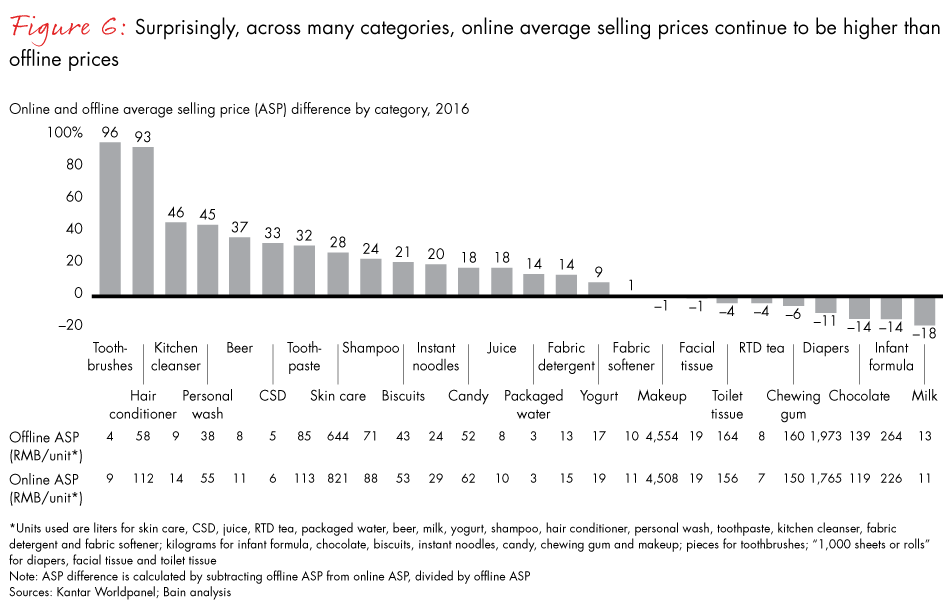

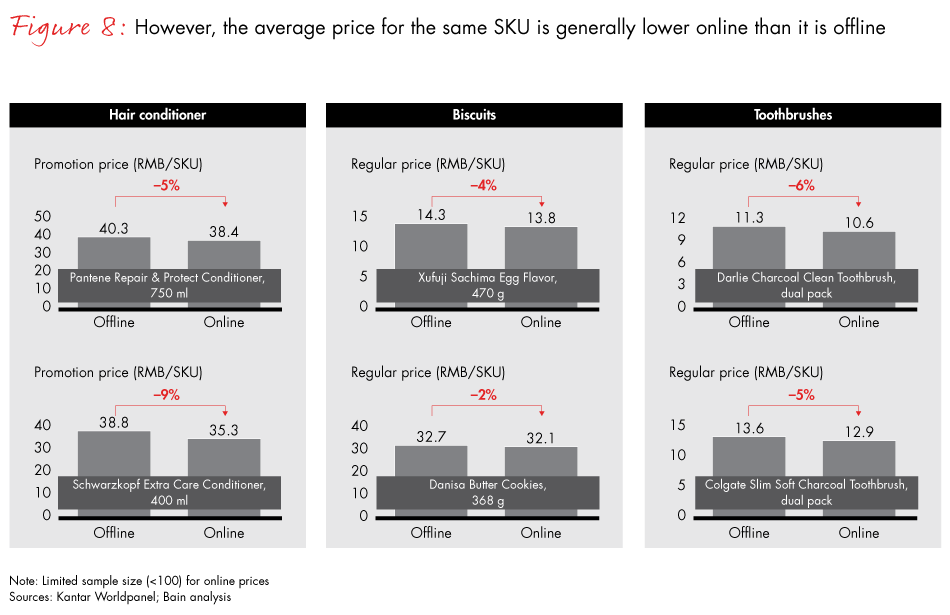
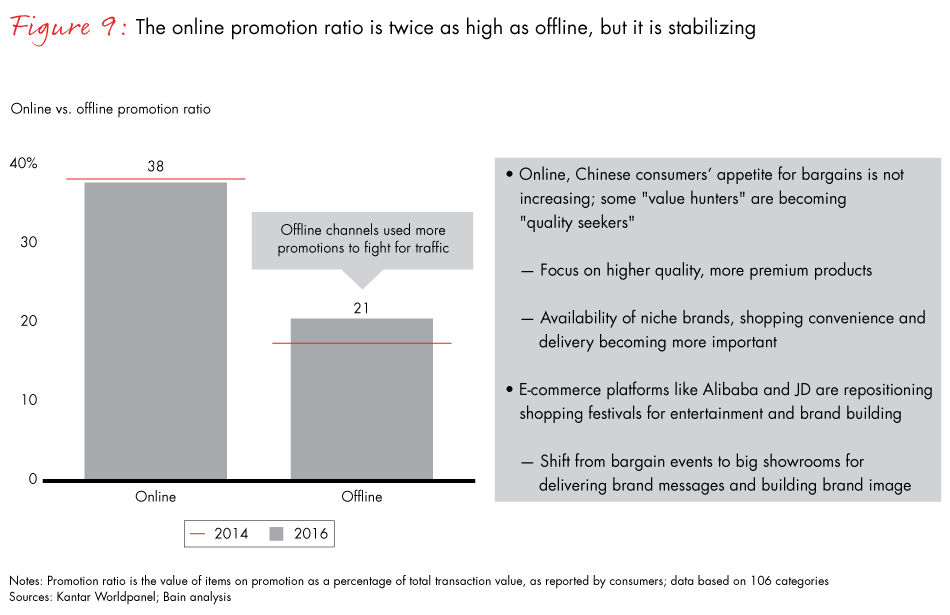
How digital isn’t changing Chinese shopper behavior
Online shopping isn’t changing brand loyalty. In previous China Shopper reports, we defined each category as either “repertoire” or “loyalist.” In repertoire categories, the more frequently consumers shop, the more brands they try. In loyalist categories, shoppers buy the same brands regardless of increasing frequency. We found that the categories still show the same repertoire or loyalist characteristics as they did in 2013 (see Figure 10), even with the shift toward e-commerce. In categories that exhibit the most loyalist activity, such as milk, diapers and infant formula, shoppers displayed the same behavior in 2016 as they did three years earlier. They may be staying loyal in part because the online channel makes it so convenient with one-click repurchasing and automatic replenishment. However, in repertoire categories such as skin care, shampoo and candy, consumers tended to buy even more brands than they did in 2013, likely because of the proliferation of new brands, including digital insurgents, entering the market.
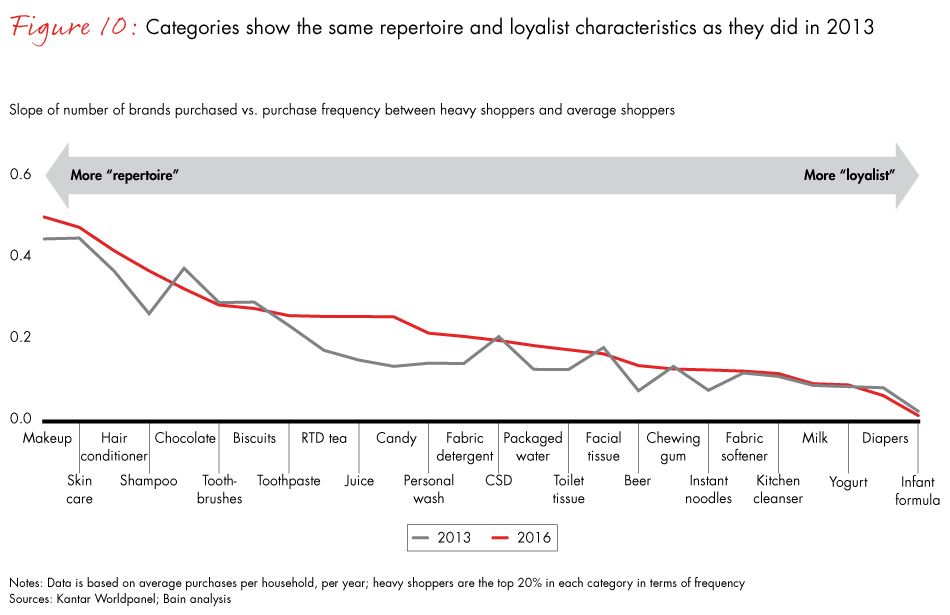
Some categories such as skin care and infant formula have high online penetration, while others such as beer and milk have much lower online penetration. Our latest analysis determined that a category’s level of online penetration doesn’t affect where it lands on the repertoire-loyalist continuum (see Figure 11). Another significant finding: Repertoire and loyalist characteristics hold even as shoppers move between online and offline channels (see Figure 12). Because e-commerce offers a seemingly endless array of products, many expected that it would lead consumers to more repertoire behavior. But the data shows that’s not the case. What’s more critical is the nature of the category itself.
Online commerce hasn’t made the FMCG market more volatile for brands. Similar to what we found in 2013, categories remain very competitive, and market share continues to be up for grabs. Across the 26 categories studied, 22% of the top 10 brands in 2013 had dropped from the list by 2016, and 7 categories had a different market leader (see Figure 13). In some categories it’s particularly tough to stay on top. For example, the market leadership position in yogurt has rotated among Mengniu, Yili and Bright. In skin care, 8 of the top 10 brands in 2013 had changed their rank three years later.
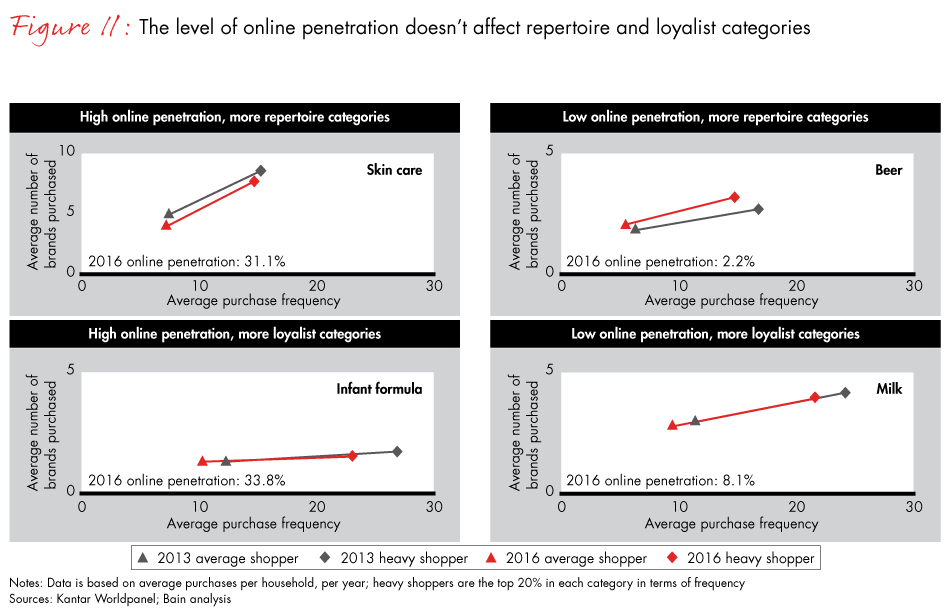
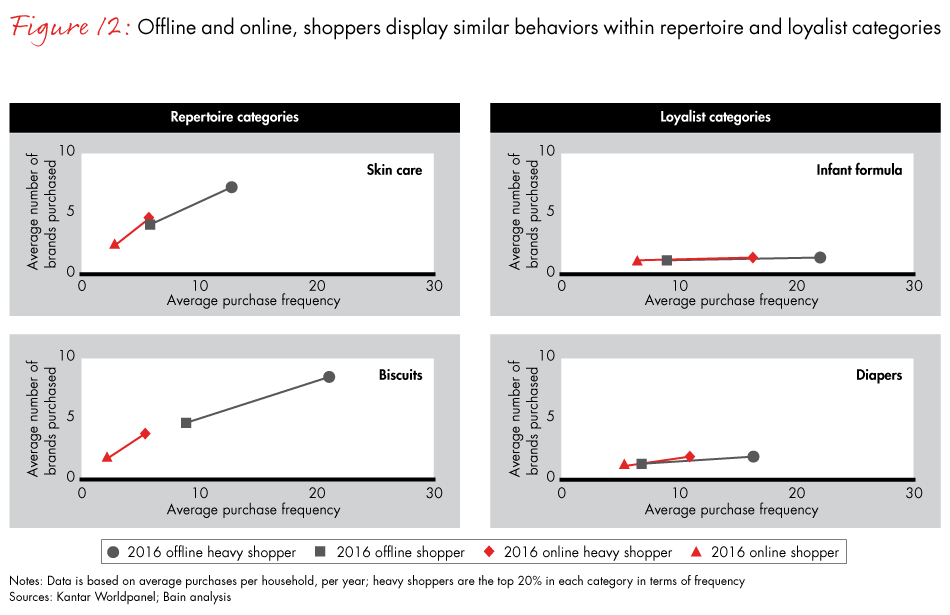
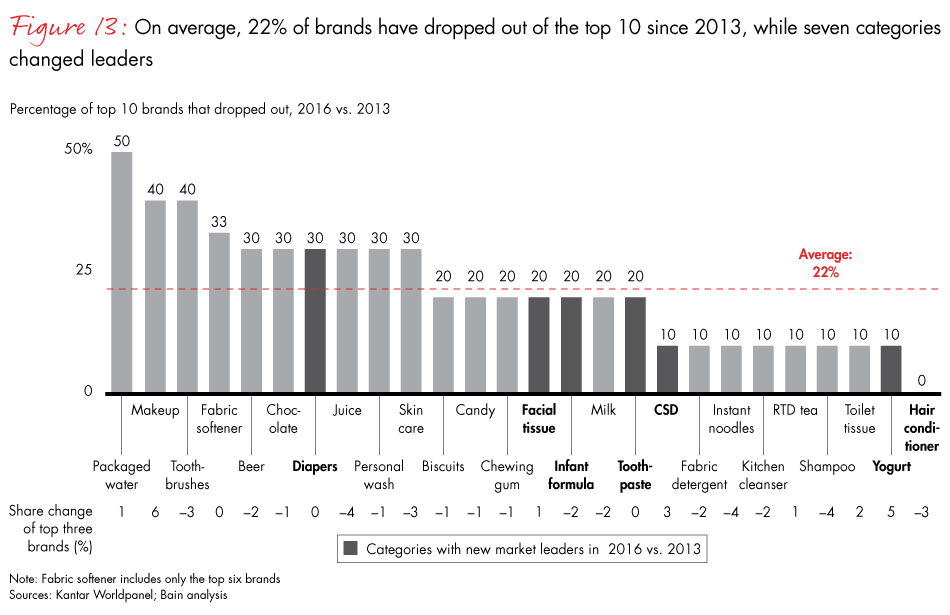
Why the focus is still on penetration
As Chinese shopper behavior evolves, one critical fact of life holds true: Market leadership is determined by a brand’s ability to boost and maintain household penetration (defined as the percentage of households in a market buying a particular brand in a given year). As we explained in China Shopper Report 2014, Vol. 2 (Chinese Shoppers: Three Things Leading Consumer Products Companies Get Right), the key to growing market share is to boost penetration. This is a major insight from the research of the Ehrenberg-Bass Institute for Marketing Science, summarized by Professor Byron Sharp, director of the Institute, in his book How Brands Grow, based on decades of observations of buying behavior. Bain & Company and Kantar Worldpanel shopper reports validate this insight. In the era of digital commerce, we find that penetration remains more important than other measurements like purchase frequency or repurchase rate. Across all categories studied, the brands that earned market leadership have significantly higher penetration than competitors (see Figure 14). In milk, Mengniu’s penetration is 5.5 times higher than the average of the top 20 brands in the category, while its purchase frequency and repurchase rate are only 1.2 and 1.3 times higher, respectively. In kitchen cleanser, Liby’s penetration rate is 10.2 times higher than the top 20 brand average, while its purchase frequency and repurchase rate are 1.3 and 1.5 times higher, respectively.
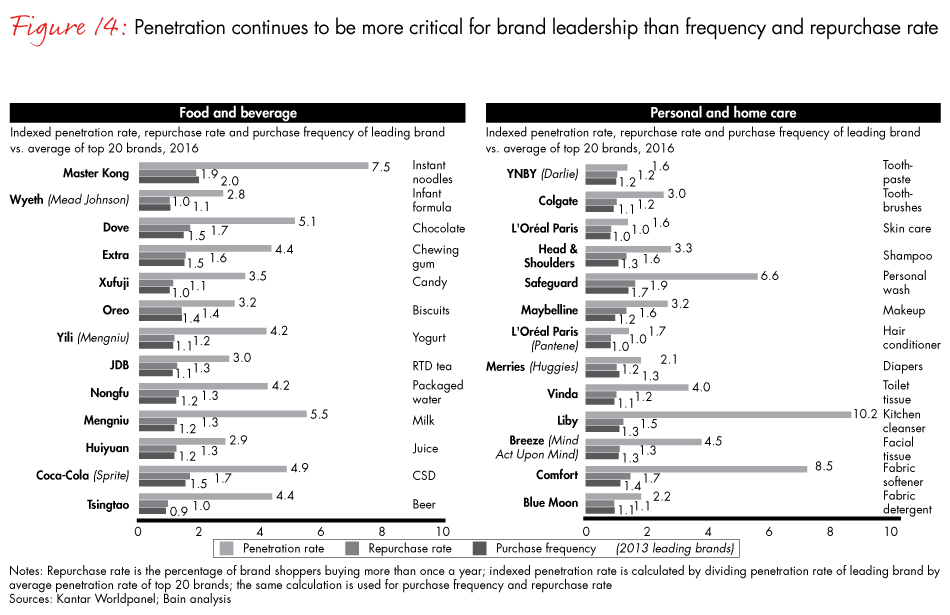
In addition, shoppers’ purchase frequency of the top brands in a category remains quite low (see Figure 15). Consider that consumers buy one of the top three beer brands an average of only 3.0 times a year. They buy one of the top three brands of toothpaste an average of 2.4 times a year. This data highlights shoppers’ low engagement with brands, even at a time when e-commerce makes products readily available for purchase.
Companies need to obsess over low-frequency shoppers—that is, those who purchase a brand only one or two times a year. For most brands, these consumers account for the majority of the shopper base and contribute most of the revenue. In the juice category, for example, shoppers who buy Huiyuan once or twice a year comprise 80% of the brand’s shopper base and account for around 50% of its revenue (see Figure 16). It’s a similar situation with large foreign brands. In skin care, low-frequency shoppers make up around 75% of Olay’s shopper base and contribute around 40% of its revenue. The revenue contribution of low-frequency shoppers underscores the fickleness of consumers. This is especially important for small brands, which depend even more on low-frequency shoppers (see Figure 17). It means brands can’t count on boosting their revenues by getting shoppers to make more frequent purchases.

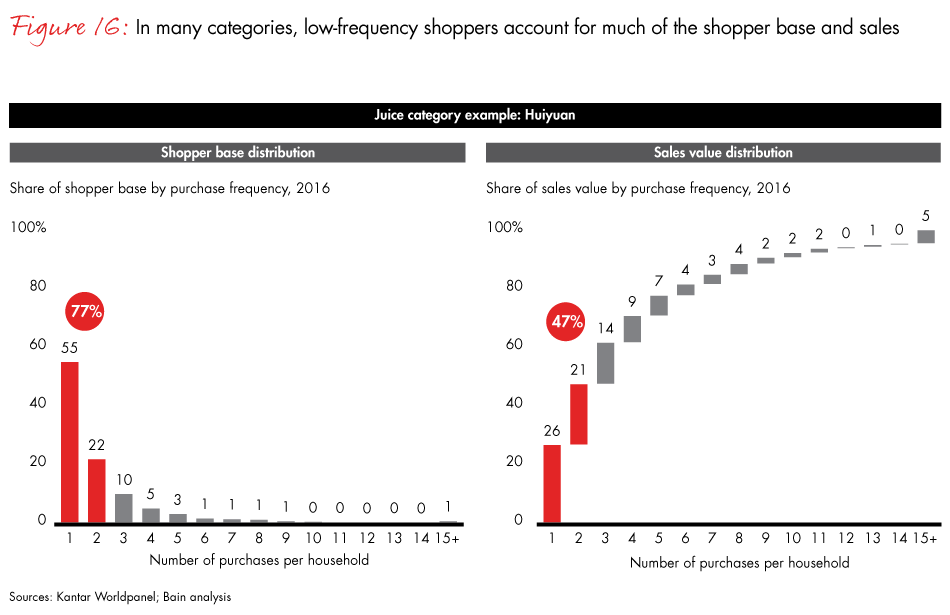
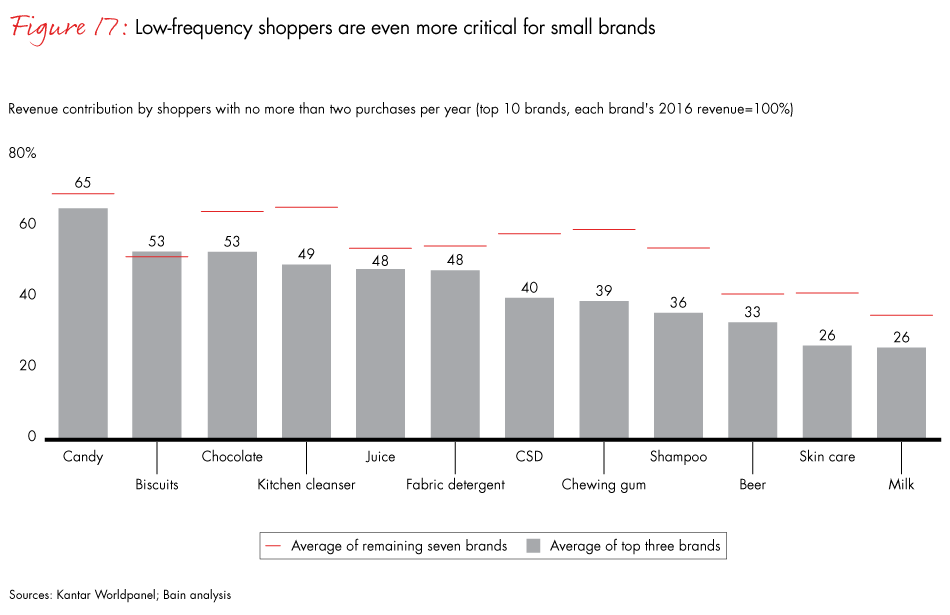
The big challenge is that the shopper base is a leaky bucket—and the holes are getting bigger each year. Chinese shoppers still love brands, but many will switch brands in a year. Among 12 categories we studied, 55% of the top five brands’ shopper bases left within 12 months, on average, accounting for 46% of revenues (see Figure 18). Meanwhile, newcomers represented 48% of the top five brands’ shopper bases, on average, and 43% of revenues (see Figure 19). More than half of Head & Shoulders’ 2014 shoppers left within a year, for example. Only 24% of the shampoo brand’s 2014 shopper base stayed for two years, and those “loyal” customers contributed only 34% of its revenue (see Figures 20 and 21).
How to continuously recruit shoppers to keep filling the leaky bucket? Yogurt brand Yili focused on its core products while launching new premium SKUs to ride the category’s premiumization trend. It emphasized above-the-line advertising (doubling its investment from 2013 to 2016) to stay on top of shoppers’ consideration lists. By sponsoring top-rated reality TV shows, the brand targeted parents, who represent the majority of its customers. It also relied on digital marketing to engage with consumers on multiple touchpoints. For its efforts, Yili boosted penetration by 9%, which helped it grow sales by more than 40% and market share by 10%. In skin care, Pechoin made similar gains in its effort to fill the leaky bucket. It increased penetration by 6% from 2013 to 2016, which delivered 44% sales growth and a 2% boost in market share during that period. Pechoin revamped its brand to be young and fresh, focusing on Chinese medicine and natural ingredients. It also successfully introduced new SKUs and premium products around its core products, promoting them by sponsoring popular TV programs.
In short, although the online channel has a much higher penetration rate than it did in 2013, consumers continue to demonstrate low engagement with brands. The rules for generating growth haven’t changed. Given the importance of low-frequency shoppers to brands’ revenues, as well as the leaky nature of the shopper base, marketers need to focus first on increasing brands’ penetration—which means that they need to constantly recruit new shoppers.
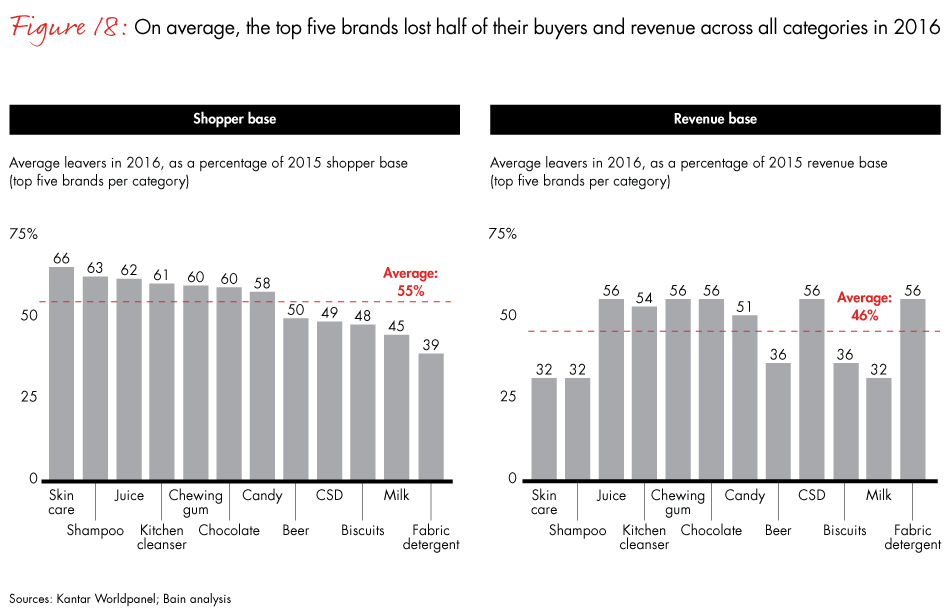
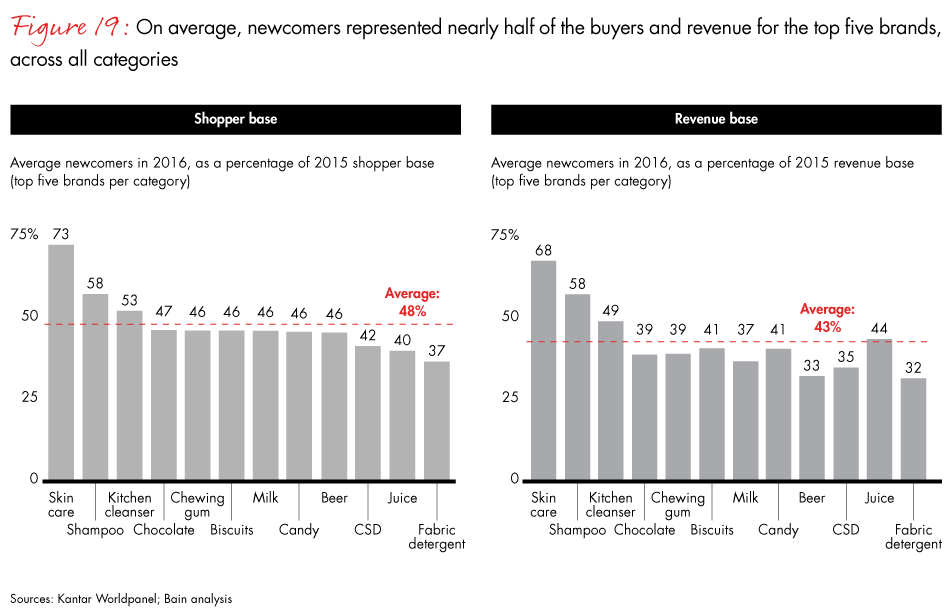
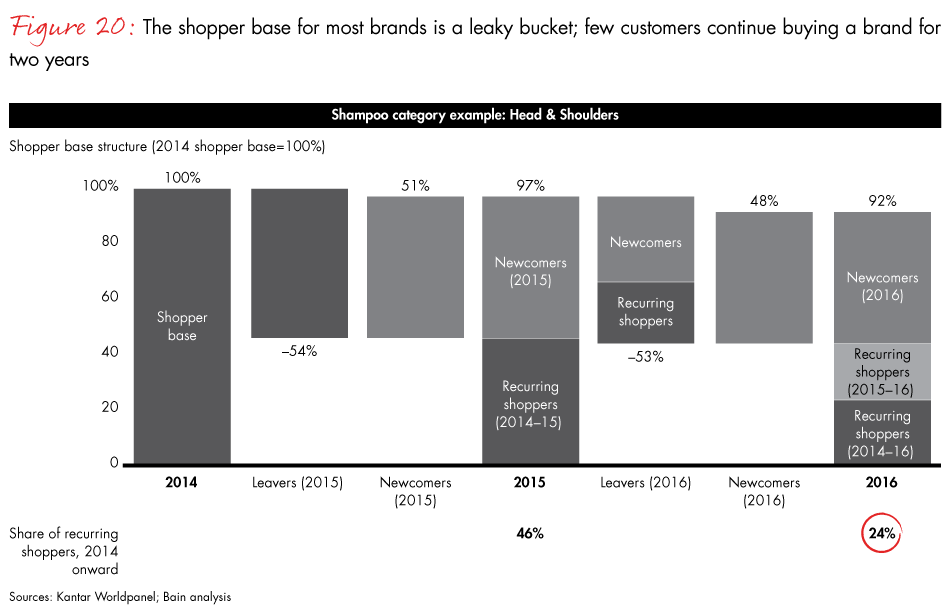
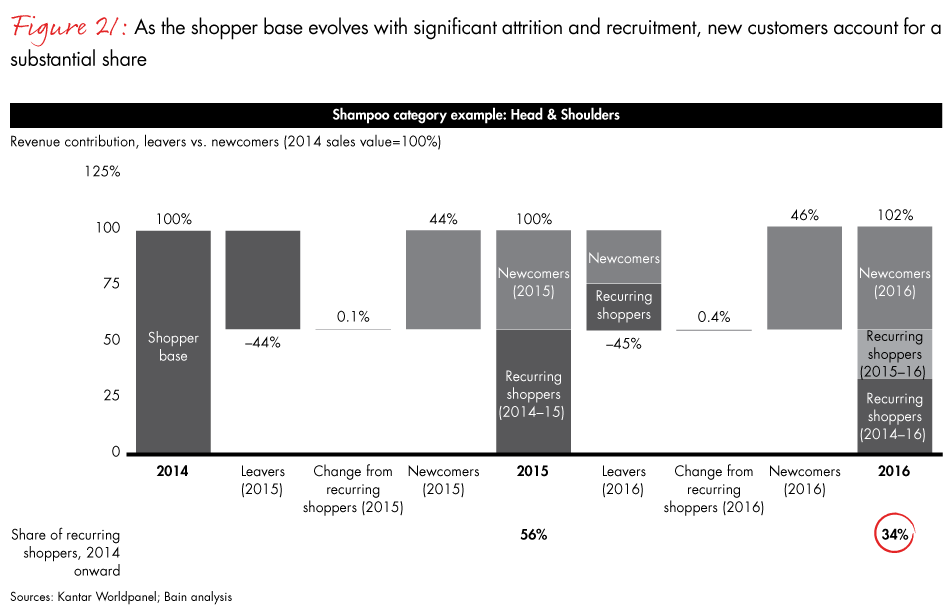
Implications for brands
In our 2014 China Shopper reports, we explained that the path to consideration and penetration requires investment in three key assets: memory structures, product portfolio and in-store execution. Those assets are more relevant than ever. But as brands navigate the two-speed growth and shopper behavior that’s evolving along with e-commerce, they need to view those assets in a digital context (see Figure 22).
- Memory structures: The goal is to build memorable, distinctive and consistent messages and connections with shoppers as they research, purchase and recommend products. Brands not only need to target wide enough audiences, but also deliver relevant communications closer to the point of purchase.
- Product portfolio: Brands can optimize their product portfolios like never before, using digital advances and agile development approaches to continuously test and learn. In addition to focusing on core SKUs, they can introduce new products specific to each channel and platform, as well as more personalized offerings.
- “In-store” assets: In today’s omnichannel world, brands must ensure perfect execution both online and offline, with a coordinated approach supported by the abundance of newly available data.
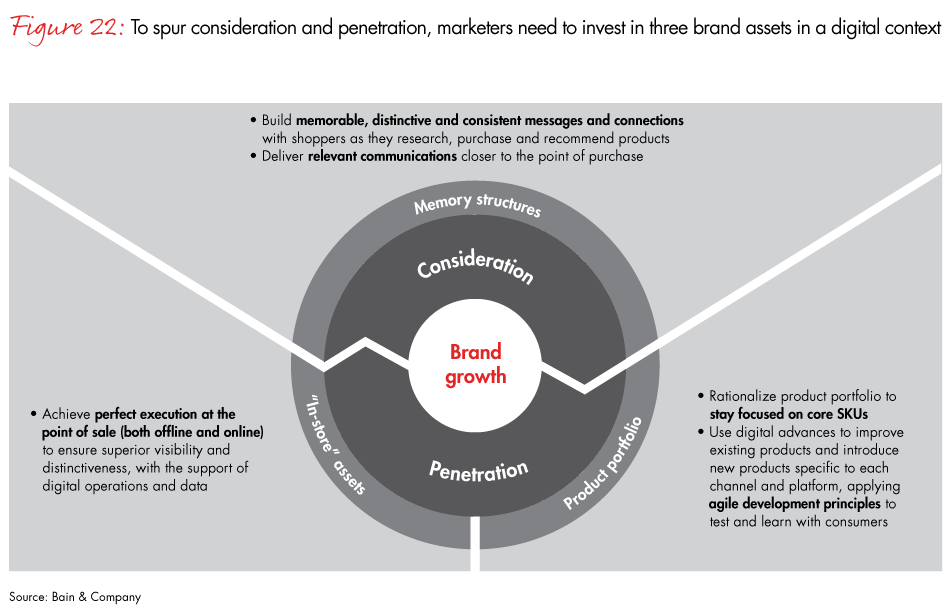
We’ll look at how two companies—one a domestic newcomer, one an established international brand—are using these assets to succeed in a digital world.
Three Squirrels. Like many brands that started online, this ubiquitous high-end nut seller has benefited from the growth of e-commerce, building both a memorable brand and a profitable business. Nimble newcomers like Three Squirrels have a lot to teach other brands.
Founded in 2012, the company created a set of likable squirrel mascots and a new lingo to establish its image: adoption for purchase, owner for customer and center for owners for customer service department. The squirrel characters engage with consumers at multiple touchpoints—interacting with them on WeChat, for example—and even star in Youku videos. In addition to this unique memory structure, the brand pays similar attention to its product portfolio. It has achieved sustained growth by focusing on its core nut products, which account for about 70% of its revenue, while introducing new SKUs around its core. Finally, it invests in winning “in-store” execution online. For e-commerce players, online store execution is just as important as in the offline world. Three Squirrels relies on effective online promotions to encourage purchases. For example, to activate impulse purchases, it offers limited-time promotions during such holidays as Chinese New Year and Mid-Autumn Festival, as well as special occasions like back to school. It also ensures visibility of promotions and hero SKUs to further increase penetration.
In line with Alibaba founder Jack Ma’s prediction of a “new retail” that combines online and offline channels, Three Squirrels recently opened physical outlets, mostly in top shopping centers in Tier-3 and Tier-4 cities, with plans to launch up to 500 locations. The new stores provide a unique customer experience. As shoppers enter, they are greeted with a story: Three squirrels were in a car accident as they traveled from the forest to the city. Since their vehicle was broken, they set up a store in the forest to sell their nuts. Designed around this story line, the stores feature sculptures of the three squirrels and a forest display, with one-third of the area devoted to resting space for customers. The stores are equipped with PDA barcode scanning systems to ensure prices are consistent with online prices in real time. Customers also can place digital orders in the stores, driving traffic to the online channel. CEO Liaoyuan Zhang has said that Three Squirrels is considering expanding into theme parks, movies, comics and tourism, following a path pioneered by Walt Disney.
L’Oréal. Rather than being swept away by the rise of digital, L’Oréal is riding the wave of change. More than 100 years old, this venerable leader in the beauty industry is embracing the digital revolution. Three components support L’Oréal’s digital transformation: digitalized marketing throughout the shopper’s decision process, digitalized products developed via a test-and-learn approach, and digitalized in-store execution to activate purchases.
Historically, shoppers have followed a well-defined path from awareness to search, to purchase, to recommendation. However, in today’s digital universe, shoppers can start that journey from any of the four activities. That’s why L’Oréal fully digitalized its engagement with consumers on multiple touchpoints. Shoppers can learn about the brand through WeChat advertisements or online video content, try on products virtually through a mobile app, make purchases by visiting its Tmall store or by following a link on an influencer’s site, and write reviews that can be shared on social media.
One question brands keep asking themselves is how to maximize sales activation through a mobile or computer screen. It can be an especially difficult challenge for skin care and makeup products; shoppers want to feel and test the products before they buy them. L’Oréal’s Makeup Genius mobile app uses augmented-reality technology to recognize users’ facial characteristics and apply virtual makeup. After they “try” a product, shoppers can place orders online directly through the app. L’Oréal has also achieved huge success by selling lipstick via live online shows hosted by celebrities and influencers, which it has found can spur impulse shopping.
The brand succeeds at the tricky art of balancing quality with speed in product development, using technology to accelerate personalized product development and keep its portfolio fresh. It collects consumer data from various demographics, and speeds up product development through test-and-learn approaches. Among its winning innovations: L’Oréal’s high-tech UV patch can recommend when a customer should apply sunscreen and which product is a best fit.
Shoppers have unique traits and behaviors. Some are value seekers while others are quality seekers. They also display different levels of interest in the functionality of skin care products. For example, some favor moisturizing while others would pay for whitening or antiaging products. Thanks to the robust data captured by e-commerce platforms and the brand itself, L’Oréal has created thousands of profiles of shopper faces, in partnership with Alibaba. Together, the brand and the platform can activate purchases by offering customized online store displays and content for different consumer segments.
This is what it takes to win today.
About the authors and acknowledgments
Bruno Lannes is a partner with Bain’s Shanghai office. Jason Ding is a partner with Bain’s Beijing office. Marcy Kou is CEO at Kantar Worldpanel Asia. Jason Yu is general manager at Kantar Worldpanel China.
Acknowledgments
This report is a joint effort between Bain & Company and Kantar Worldpanel. The authors extend gratitude to all who contributed to this report, in particular Iris Wang, Miki Yu, Roger Wu and Hannah Long from Bain, and Rachel Lee, Tina Qin and Cathrine Chang from Kantar Worldpanel.
1 These 26 categories are a) packaged food: biscuits, chocolate, instant noodles, candy, chewing gum and infant formula; b) beverages: milk, yogurt, juice, beer, ready-to-drink (RTD) tea, carbonated soft drinks (CSD) and packaged water; c) personal care: skin care, shampoo, personal wash, toothpaste, makeup, hair conditioner, diapers and toothbrushes; and d) home care: toilet tissue, fabric detergent, facial tissue, kitchen cleanser and fabric softener.





















